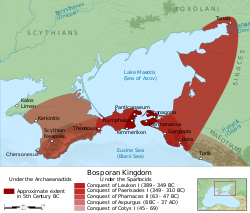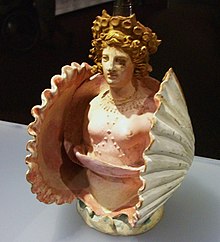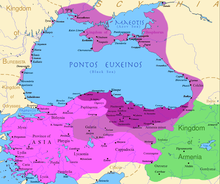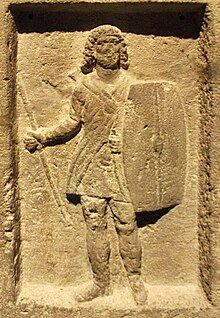Bosporan Kingdom
Kingdom of the Cimmerian Bosporus Βασίλειον τοῦ Κιμμερικοῦ Βοσπόρου | |||||||||||
|---|---|---|---|---|---|---|---|---|---|---|---|
| c. 438 BC[1] – c. 370 AD | |||||||||||
 Map showing the early growth of the Bosporan Kingdom, before its annexation by Mithridates VI of Pontus. | |||||||||||
| Status |
| ||||||||||
| Capital | Panticapaeum | ||||||||||
| Common languages | |||||||||||
| Religion | Greek polytheism[2] | ||||||||||
| Government | Monarchy | ||||||||||
| Basileus | |||||||||||
• 389 BC | Leukon I | ||||||||||
• c. 341 AD | Rhescuporis VI | ||||||||||
| Historical era | Antiquity | ||||||||||
• Established | c. 438 BC[1] | ||||||||||
• Disestablished | c. 370 AD | ||||||||||
| Currency |
| ||||||||||
| |||||||||||
| Today part of | |||||||||||
The Bosporan Kingdom, also known as the Kingdom of the Cimmerian Bosporus (Greek: Βασίλειον τοῦ Κιμμερικοῦ Βοσπόρου, Basileion tou Kimmerikou Bosporou), was an ancient Greco-Scythian state located in eastern Crimea and the Taman Peninsula on the shores of the Cimmerian Bosporus, the present-day Strait of Kerch. It was the first truly 'Hellenistic' state in the sense that a mixed population adopted the Greek language and civilization. The Bosporan Kingdom became the longest surviving Roman client kingdom. The 1st and 2nd centuries AD saw a period of a new golden age of the Bosporan state. It was briefly incorporated as part of the Roman province of Moesia Inferior from 63 to 68 AD, under Emperor Nero, before being restored as a Roman client kingdom. At the end of the 2nd century AD, King Sauromates II inflicted a critical defeat on the Scythians and included all the territories of the Crimea in the structure of his state.
The prosperity of the Bosporan Kingdom was based on the export of wheat, fish and slaves. Such, the Kingdom became the economic center of the Black Sea and is often dubbed the ancient Jewel of the Black Sea.[3] The profit of the trade supported a class whose conspicuous wealth is still visible from newly discovered archaeological finds, excavated, often illegally, from numerous burial barrows known as kurgans. The once-thriving cities of the Bosporus left extensive architectural and sculptural remains, while the kurgans continue to yield spectacular Greco-Sarmatian objects, the best examples of which are now preserved in the Hermitage in St. Petersburg. These include gold work, vases imported from Athens, coarse terracottas, textile fragments, and specimens of carpentry and marquetry.
Early Greek colonies[]

The whole area was dotted with Greek cities: in the west, Panticapaeum (Kerch)—the most significant city in the region, Nymphaeum and Myrmekion; on the east Phanagoria (the second city of the region), Kepoi, Hermonassa, Portus Sindicus and Gorgippia.[4]
These Greek colonies were originally settled by Milesians in the 7th and 6th centuries BC. Phanagoria (c. 540 BC) was a colony of Teos, and the foundation of Nymphaeum may have had a connection with Athens; at least it appears to have been a member of the Delian League in the 5th century.[4]
Geography[]
The Bosporan Kingdom was centred around the Kerch Strait between the Black Sea and the Sea of Azov, known in antiquity as the Cimmerian Bosporus from where the kingdom's name derived.
Kings of Cimmerian Bosporus[]

Archaeanactidae dynasty[]
According to Greek historian Diodorus Siculus (xii. 31) the region was governed between 480 and 438 BC by a line of kings called the Archaeanactidae, probably a ruling family, usurped by a tyrant called Spartocus (438–431 BC), who was a Thracian.[4]
Spartocid dynasty[]
Spartocus founded a dynasty which seems to have endured until c. 110 BC, known as the Spartocids. The Spartocids left many inscriptions, indicating that the earliest members of the house ruled under the titles of archons of the Greek cities and kings of various minor native tribes, notably the Sindi (from central Crimea) and other branches of the Maeotae. Surviving material (texts, inscriptions and coins) do not supply enough information to reconstruct a complete chronology of kings of the region.[4]

Satyrus (431–387 BC), successor to Spartocus, established his rule over the whole region, adding Nymphaeum to his kingdom and besieging Theodosia, which was wealthy because, unlike other cities in the region, it had a port which was free of ice throughout the year, allowing it to trade grain with the rest of the Greek world, even in winter. Satyrus' son Leucon (387–347 BC) eventually took the city. He was succeeded jointly by his two sons, Spartocus II, and Paerisades; Spartocus died in 342 BC, allowing Paerisades to reign alone until 310 BC.[4] After Paerisades' death, a war of succession between his sons Satyrus and Eumelus was fought. Satyrus defeated his younger brother Eumelus at the Battle of the River Thatis in 310 BC but was then killed in battle, giving Eumelus the throne.[5]
Eumelus' successor was Spartocus III (303–283 BC) and after him Paerisades II. Succeeding princes repeated the family names, so it is impossible to assign them a definite order. The last of them, however, Paerisades V, unable to make headway against increasingly violent attacks from nomadic tribes in the area, called in the help of Diophantus, general of King Mithridates VI of Pontus, leaving him his kingdom. Paerisades was killed by a Scythian named Saumacus who led a rebellion against him.[4]
The house of Spartocus was well known as a line of enlightened and wise princes; although Greek opinion could not deny that they were, strictly speaking, tyrants, they are always described as dynasts. They maintained close relations with Athens, their best customer for the Bosporan grain exports: Leucon I of Bosporus created privileges for Athenian ships at Bosporan ports. The Attic orators make numerous references to this. In return the Athenians granted Leucon Athenian citizenship and made decrees in honour of him and his sons.[4]
Mithridates VI[]

After his defeat by Roman General Pompey in 66 BC, King Mithridates VI of Pontus fled with a small army from Colchis (modern Georgia) over the Caucasus Mountains to Crimea and made plans to raise yet another army to take on the Romans. His eldest living son, Machares, regent of Cimmerian Bosporus, was unwilling to aid his father, so Mithridates had Machares killed, acquiring the throne for himself. Mithridates then ordered the conscriptions and preparations for war. In 63 BC, Pharnaces, the youngest son of Mithridates, led a rebellion against his father, joined by Roman exiles in the core of Mithridates's Pontic army. Mithridates VI withdrew to the citadel in Panticapaeum, where he committed suicide. Pompey buried Mithridates VI in a rock-cut tomb in either Sinope or Amasia,[6] the capital of the Kingdom of Pontus.
Roman client kingdom[]

After the death of Mithridates VI (63 BC), Pharnaces II (63–47 BC) supplicated to Pompey, and then tried to regain his dominion during Julius Caesar's Civil War, but was defeated by Caesar at Zela and was later killed by his former governor and son-in-law Asander.[4]
Before the death of Pharnaces II, Asander had married Pharnaces II's daughter Dynamis. Asander and Dynamis were the ruling monarchs until Caesar commanded a paternal uncle of Dynamis, Mithridates II to declare war on the Bosporan Kingdom and claimed the kingship for himself. Asander and Dynamis were defeated by Caesar's ally and went into political exile. However, after Caesar's death in 44 BC, the Bosporan Kingdom was restored to Asander and Dynamis by Caesar's great nephew and heir Octavian. Asander ruled as an archon and later as king until his death in 17 BC. After the death of Asander, Dynamis was compelled to marry a Roman usurper called Scribonius, but the Romans under Agrippa intervened and established Polemon I of Pontus (16–8 BC) in his place. Polemon married Dynamis in 16 BC and she died in 14 BC. Polemon ruled as king until his death in 8 BC. After the death of Polemon, Aspurgus, the son of Dynamis and Asander, succeeded Polemon.
The Bosporan Kingdom of Aspurgus was a client state of the Roman Empire, protected by Roman garrisons. Aspurgus (8 BC – 38 AD) founded a dynasty of kings which endured with a couple of interruptions until 341 AD. Aspurgus adopted the Imperial Roman names "Tiberius Julius" when he received Roman citizenship and enjoyed the patronage of the first two Roman Emperors, Augustus and Tiberius. All of the following kings adopted these two Roman names followed by a third name, of Thracian (Kotys, Rhescuporis or Rhoemetalces) or local origin (such as Sauromates, Eupator, Ininthimeus, Pharsanzes, Synges, Terianes, Theothorses or Rhadamsades).

The Roman client kings of the dynasty had descended from King Mithridates VI of Pontus and his first wife, his sister Laodice, through Aspurgus. The kings adopted a new calendar (the "Pontic era") introduced by Mithridates VI, starting with 297 BC to date their coins. Bosporan kings struck coinage throughout its period as a client state, which included gold staters bearing portraits of both the Roman emperor and Bosporan king. Like the Roman, Bosporan coinage became increasingly debased during the 3rd century. The coinage makes their lineages fairly clear to historians, though scarcely any events from their reigns are recorded.
The Bosporan Kingdom covered the eastern half of Crimea and the Taman peninsula, and extended along the east coast of the Maeotian marshes to Tanais at the mouth of the Don in the north-east, a great market for trade with the interior. Throughout the period there was perpetual war with the native tribes of Scythians and Sarmatians, and in this the Bosporan Kingdom was supported by its Roman suzerains, who lent the assistance of garrisons and fleets.

In 62 AD for reasons unknown, Roman emperor Nero deposed the Bosporan king Cotys I.[7] It is possible that Nero wanted to minimise the power of local client rulers and wanted the Bosporans to be subsumed into the Roman empire. The Bosporan Kingdom was incorporated as part of the Roman province of Moesia Inferior from 63 to 68. In 68, the new Roman emperor Galba restored the Bosporan Kingdom to Rhescuporis I, the son of Cotys I.
Following the Jewish diaspora, Judaism emerged in the region, and Jewish communities developed in some of the cities of the region (especially Tanais). The Jewish or Thracian influence on the region may have inspired the foundation of a cult to the "Most High God", a distinct regional cult which emerged in the 1st century AD,[2] which professed monotheism without being distinctively Jewish or Christian.[8]
The balance of power amongst local tribes was severely disturbed by westward migration in the 3rd–4th centuries. In the 250s AD, the Goths and Borani were able to seize Bosporan shipping and even raid the shores of Anatolia.[9]
With the coins of the last king Rhescuporis VI in 341, constructing a chronology becomes very difficult. The kingdom was probably finally overrun by the Huns, who defeated the nearby Alans in 375/376 and moved rapidly westwards towards the Roman empire.[4]
Byzantine period[]
A few centuries after the Hunnic invasion, the Bosporan cities enjoyed a revival, under Byzantine and Bulgarian protection. The ancient Greek city of Phanagoria became the capital of Old Great Bulgaria between 632 and 665.[citation needed] From time to time Byzantine Greek officers built fortresses and exercised authority at Bosporus, which constituted an archbishopric.
A relevant Byzantine usage of the term is found in a newly discovered seal of a general of the early 11th century as of "Πο⟨σ⟩φορ(ου)", i.e., of the Cimmerian Bosporos.[10]
They also held Tmutarakan on the eastern side of the strait, a town which in the 10th and 11th centuries became the seat of the Kievan Rus principality of Tmutarakan, which in turn gave way to Tatar domination.[4]
Coinage[]

Although considered rare among collectors prior to the demise of the Soviet Union in 1991, Bosporan coins are now well known on the international coin markets, hinting at the quantities produced. Several large series were produced by Bosporan cities from the 5th century BC, particularly in Panticapaeum. Gold staters of Panticapaeum bearing Pan's head and a griffin are especially remarkable for their weight and fine workmanship.
There are coins with the names of the later Spartocids and a complete series of dated solidi issued by the later or Achaemenian dynasty. In them may be noticed the swift degeneration of the gold solidus through silver and potin to bronze.[11]
See also[]
- Cimmerians
- Cimmerian Bosporus
- Kingdom of Pontus
- Spartocids
- Tanais Tablets
References[]
- ^ Hind, John. "The Bosporan Kingdom". In Lewis, D. M.; Boardman, J.; Hornblower, S.; Ostwald, M. (eds.). The Cambridge Ancient History. VI - The 4th Century BC. Cambridge: CUP. pp. 476–511.
- ^ Jump up to: a b Kozlovskaya, Valeriya (10 December 2001). "Review of The Supreme Gods of the Bosporan Kingdom". Bryn Mawr Classical Review. Archived from the original on 6 April 2012. Retrieved 6 February 2013.
- ^ "How the Bosporan Kingdom Became the Jewel of the Black Sea". 26 December 2018.
- ^ Jump up to: a b c d e f g h i j Minns, Ellis (1911). . In Chisholm, Hugh (ed.). Encyclopædia Britannica. 4 (11th ed.). Cambridge University Press. pp. 286–287.
- ^ Head, Duncan. Armies of the Macedonian and Punic Wars. p. 70.
- ^ Hojte, Jakob Munk. "The Death and Burial of Mithridates VI". Archived from the original on 2016-03-03. Retrieved 3 February 2015.
- ^ Bunson, Matthew (1995). A dictionary of the Roman Empire. New York: Oxford University Press. p. 116. ISBN 0195102339.
- ^ Schuerer, E. (1897). "Die Juden im Bosporansichen Reiche und die Genossenschaften der sebomenoi theon upsiston ebendaselbst" [The Jews in the Bosporan Kingdom and the sebomenoi theon upsiston of the region]. Sitzungsberichte der Preussischen Akademie der Wissenschaft. 1. "Sebomenoi theon upsiston" (σεβομενοι θεον υψιστον) is Greek for "worshippers of God most high".
- ^ Pitassi, Michael (2010). The navies of Rome (paperback ed.). Woodbridge: Boydell. p. XV. ISBN 978-1843836001.
- ^ Constantine Zuckerman. "Byzantium's Pontic Policy in the Notitiae Episcopatuum". La Crimée entre Byzance et le Khaganat khazar, Paris, 2006. p. 224
- ^ "The Bosporan Kingdom". Classical Numismatic Group (CNG). 66 (Lot 1018). 19 May 2004. Retrieved 6 February 2013.
Further reading[]
- Overview
- Ascherson, Neal (1996). Black Sea. New York: Hill and Wang. ISBN 9780809015931.
- Fornasier, Jochen; Böttger, Burkhard (2002). Das Bosporanische Reich: der Nordosten des Schwarzen Meeres in der Antike (in German). Mainz: Philipp von Zabern. ISBN 978-3805328951.
- Social, economic and cultural
- Bekker-Nielsen, Tønnes (2006). Rome and the Black Sea Region. Domination, Romanisation, Resistance. Aarhus University Press.
- Gabrielsen, Vincent & Lund, John (2007). The Black Sea in Antiquity: Regional and Interregional Economic Exchanges. Aarhus University Press.
- Ustinova, Yulia (1998). The Supreme gods of the Bosporan Kingdom : Celestial Aphrodite and the Most High God. Leiden: Brill. ISBN 9004112316.
- Political and military
- Mielczarek, Mariusz [trans. by Nicholas Sekunda] (1999). The Army of the Bosporan Kingdom. Łódź: Oficyna Naukowa MS. ISBN 978-8385874034.
- Munk Højte, Jakob (2009). Mithridates VI and the Pontic Kingdom. Aarhus University Press.
- Numismatic
External links[]
| Wikimedia Commons has media related to Bosporan Kingdom. |
- Rare and Unique Coins of Bosporan Kingdom. Bulletin of the Odessa Numismatics Museum. Issues 7,8,9. 2001. Odessa. Ukraine.
- Artezian, a fortified settlement on the Crimean Peninsula
Coordinates: 45°15′36″N 37°02′24″E / 45.26000°N 37.04000°E
- Bosporan Kingdom
- Former kingdoms
- Greek colonies in Crimea
- Hellenistic Pontus
- Hellenistic states
- Ancient history of Ukraine
- History of the Black Sea
- Ancient Crimea
- Iron Age countries in Europe
- Prehistoric Russia
- Sea of Azov
- Scythia
- Former monarchies of Europe
- States and territories established in the 5th century BC
- 5th-century BC establishments
- States and territories disestablished in the 4th century
- 4th-century disestablishments
- Roman client kingdoms
- Ukraine in the Roman era

